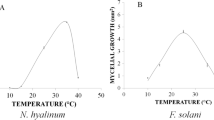Abstract
Stem decay and root rot of Amaranthus hybridus, caused by Fusarium oxysporum is a serious threat to the commercial production of this crop in South Africa. Five Amaranthus hybridus varieties were examined in vitro for sensitivity to a culture filtrate of Fusarium oxysporum. The phytotoxicity of the culture filtrate was assessed for its inhibitory effect on callus and seeding root growth, as well as on the viability of callus cells. The five varieties exhibited a significant amount of variation in response to the culture filtrate of the pathogen. Variety 17 was the most sensitive variety in each bioassay, whereas variety 20 displayed least sensitivity to the culture filtrate. Callus of variety 20 grew well in the presence of concentrations of culture filtrate that were toxic to another four varieties and the percentage mortality of callus cells after exposure to the filtrate was also the lowest of the five varieties. Root growth of variety 20 was also least affected by exposure to the culture filtrate for up to 6 days. To our knowledge, the presence of resistance in germplasm of A. hybridus to culture filtrates of F. oxysporum has not been demonstrated before. The present study is therefore of significant value to breeding programs aimed at speedily finding amaranth cultivars that are resistant to this important pathogen.
Similar content being viewed by others
References
Behnke, M., 1980. General resistance to late blight of Solanum tuberosum plants regenerated from callus resistant to culture filtrate of Phytophthora infestans. Theor Appl Genet 56: 151–152.
Bennici, A., S. Schiff & R. Bovelli, 1992. In vitro culture of species and varieties of four Amaranthus L. species. Euphytica 62: 181–186.
Blodgett, J.T., W.J. Swart & S. vdM. Louw, 1998. First report of Fusarium sambucinum, F. oxsysporum and F. subglutinans associated with stem decay of Amaranthus hybridus in South Africa. Plant Dis 82: 1062.
Chen, W.Q. & W.J. Swart, 2000. Fusarium oxysporum and F. sambucinum associated with root rot of Amaranthus hybridus in South Africa. Plant Dis 84: 101.
Daub, M.E., 1986. Tissue culture and the selection of resistance to pathogens. Ann Rev Phytopathol 24: 159–186.
Harlan, J.R., 1992. Crops and Man. 2nd ed. Madison, WI: American Soc. Agronomy, 284 p.
Hartman, C.L., T.J. McCoy & T.R. Knous, 1984. Selection of alfafa (Medicago sativa) cell lines and regeneration of plants resistant to the toxin(s) produced by Fusarium oxysporum f. sp. medicaginis. Plant Sci Lett 34: 183–194.
Huang, Y.H. & G.L. Hartman, 1998. Reaction of selected soybean genotypes to isolates of Fusarium solani f. sp. glycines and their culture filtrates. Plant Dis 82: 999–1002.
Jin, H., G.L. Hartman, C.D. Nickell & J.M. Widholm, 1996a. Characterization and purification of a phytotoxin produced by Fusarium solani, the causal agent of Soybean Sudden Death Syndrome. Phytopathology 86: 277–281.
Jin, H., G.L. Hartman, C.D. Nickell & J.M. Widholm, 1996b. Phytotoxicity of culture filtrate from Fusarium solani, the causal agent of Soybean Sudden Death Syndrome of soybean. Plant Dis 80: 922–927.
Kauffman, C.S. & P.W. Haas, 1983. Grain amaranth: a crop with low water requirements and high nutritional value. In: W. Lockeretz (Ed.), Environmentally Sound Agriculture, Selected Papers. 4th Conference, International Federation of Organic Agriculture Movements, Cambridge, Mass., August 18-20 1982, pp. 299–313. Praeger, New York.
Kauffman, C.S. & L.E. Weber, 1990. Grain amaranth. In: J. Janick & J.E. Simon (Eds.), Advances in New Crops: Proceedings of the First National Symposium on New Crops, Research, Development, Economics. Indianapolis, Indiana, Oct. 23–26 1988, pp. 127–139. Timber Press, Portland, OR.
Kintzios, S., A. Koloopoulos, E. Karyoti, J. Drossopoulos, C.D. Holevas, A. Grigoriu & C.G. Panagopoulos, 1996. In vitro reaction of Sunflower (Helianthus annuus L.) to the toxin(s) produced by Alternaria alternata, the casual agent of brown leaf spot. J Phytopathol 144: 465–470.
Li, S., G.L. Hartman & J.M. Widholm, 1999. Viability staining of soybean suspension-cultured cells and a seedling stem cutting assay to evaluate phytotoxicity of Fusarium solani f. sp. glycines culture filtrates. Plant Cell Rep 18: 375–380.
Lim, S.M., H.S. Song & L.E. Gray, 1990. Phytotoxicity of culture filtrate from Fusarium solani isolated from soybean (Abstract). Phytopathology 80: 1044.
Mehta, Y.R. & R.L. Brogin, 2000. Phytotoxicity of a culture filtrate produced by Stemphylium solani of cotton. Plant Dis 84: 838–842.
Murashige, T. & F. Skoog, 1962. A revised medium for rapid growth and bioassays with tobacco tissue cultures. Plant Physiol 5: 473–498.
Nelson, P.E., T.A. Toussoun & W.F.O. Marasas, 1983. Fusarium species: An Illustrated Manual for Identification. The Pennsylvania State University Press, University Park.
Rawate, P.D., 1983. Amaranth (pigweed): a crop to help solve the world protein shortage. In: W. Lockeretz (Ed.), Environmentally Sound Agriculture, Selected Papers. 4th Conference, International Federation of Organic Agriculture Movements, Cambridge, Mass., August 18-20, 1982. Praeger, New York, pp. 287–298.
Remotti, P.C., H.J.M. Loffler & L. van Vloten-Doting, 1997. Selection of cell-lines and regeneration of plants resistant to fusaric acid from Gladiolus x grandiflorus cv. ‘Peter Pears’. Euphytica 96: 237–245.
Steele, R.G. & J.H. Torrie, 1980. Principles and Procedures of Statistics. 2nd ed. McGraw-Hill, New York.
Swart, W.J., W.C. Saaiman & W.-M. Botes, 1994. Use of isolated root cap cells and cell cultures from Pinus spp. in an assay for toxin production by Sphaeropsis sapinea (Abstract). Phytopathology 84: 1144.
Van den Bulk, R.W., 1991. Application of cell and tissue culture and in vitro selection for disease resistance breeding - A review. Euphytica 56: 269–285.
Wedge, D.E., S.D. McElreath & F.H. Tainter, 1993. A bioassay for studying toxic metabolites of Discula destructive (Abstract). Phytopathology 83: 1393.
Yoder, O.C., 1981. Assay. In: R.D Durbin (Ed.), Toxins in Plant Disease, pp. 45–78. Academic Press, New York.
Author information
Authors and Affiliations
Rights and permissions
About this article
Cite this article
Chen, WQ., Swart, W.J. The in vitro phytotoxicity of culture filtrates of Fusarium oxysporum to five genotypes of Amaranthus hybridus . Euphytica 127, 61–67 (2002). https://doi.org/10.1023/A:1019980600219
Issue Date:
DOI: https://doi.org/10.1023/A:1019980600219




